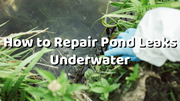
Few things feel worse than waking to find your pond down three inches, the pump wheezing, and lilies listing sideways. Draining the entire feature to hunt pin-hole leaks is messy, risky for fish, and a guaranteed weekend-killer. The good news: underwater repairing of leakage in HDPE geomembrane pond liners is straightforward once you know what to look for and have the right tools on hand. Follow the roadmap below, sprinkle in a couple of Poposoap-style solar upgrades, and you’ll finish your pond repairs before the coffee gets cold.
Why Pond Liner Repairs Matter
- Stable chemistry – Constant top-ups for a leak swing pH, hardness, and salinity; delicate fish feel every shift.
- Pump protection – A skimmer that gulps air burns out quickly, adding a second item to the pond repairs list.
- Structural integrity – Exposed liners dry out, crack, and invite burrowing critters, turning a pinhole into a split seam.
- Eco-sense – Losing 50 gallons a day wastes treated city water, and the energy used to pump it.

A watertight pond, in short, is prettier, cheaper, and kinder to the fish and plants you love.
What Causes Leaks in Pond Liners?
- Punctures – Fallen branches, pet claws, or the forgotten trowel on a planting shelf.
- UV fatigue – Older EPDM and HDPE that sits above the waterline cracks like aged vinyl.
- Freeze–thaw flexing – Ice expansion in winter torques folds and stressed welds.
- Root or rodent attack – Willow roots needle holes; muskrats chew fist-size exits.
- Equipment abrasion – Pumps or light cables rubbing the liner 24/7 thin a spot that finally gives way.

Spotting these early keeps pond liner repairs small and inexpensive.
How to Locate a Leak Underwater
- Measure the drop. Mark the current level, wait 24 hours, re-check. A loss >½ inch daily almost never comes from evaporation alone.
- Slow refill. Add water and watch where the fall slows—your hole sits just above that horizon.
- Visual patrol. Polarized sunglasses reveal tiny debris vortexes spiralling into pinholes.
- Milk-or-dye test. Squirt diluted milk or pond-safe dye near suspect folds; watch for a ribbon jetting into the liner.
- Glove sweep. With water still clear, slide a gloved hand along seams; suction tugs at your fingertips where the liner pulls water.
Tools & Materials You’ll Need
- Underwater EPDM/HDPE patch kit with solvent wipe, primer, and self-adhesive disc
- Pool-grade butyl tape for extra edge grip on wrinkled liners
- Small stainless-steel roller (or smooth dowel) to purge air bubbles
- Optional PVC/ABS backing plate to support large gashes
- Mask & snorkel or hip waders for comfort in deeper zones
- Battery headlamp to illuminate shaded folds
- Poposoap floating aerator to keep oxygen up while silt clouds the water
Step-by-Step: Repairing a Leak Without Draining
- Reduce heavy flow. Dial main pumps to half-rate; let a Poposoap solar fountain maintain surface ripple for oxygen.
- Expose clean liner. Brush off algae; wipe silt with pond water only.
- Blot-dry. Press an absorbent rag over the site—patches bond to damp plastic, not mud.
- Prime the area. Solvent-wipe a circle twice the patch diameter; flash-dry 30–60 seconds.
- Apply the patch. Peel, align, press Centre-out, then roll firmly to eject air.
- Edge seal. If folds prevent a perfect lay-flat, run a thin bead of butyl tape around the patch’s perimeter.
- Cure and test. Allow two hours for 80 % strength, 24 hours before restoring full pump flow; mark the waterline and confirm no further loss.
Tech Tip: For tears wider than two fingers, slide a backing plate beneath the liner before patching to give the adhesive something solid to bite.
When to Replace Instead of Repair
- Multiple leaks on liners 15 years or older
- Long, branching cracks—material is failing, not punctured
- Severe root intrusion you can’t safely remove
- Plans to deepen or reshape the pond
If replacement makes sense, install the new geomembrane with future plumbing in mind. A Poposoap waterfall pump kit or modular filter box can drop in as you back-fill, streamlining maintenance.
Long-Term Liner-Care Habits
- Aerate the depths to vent toxic gases and ease pressure under liners.
- Basket your plants to keep roots from stabbing soft HDPE.
- Shield exposed edges with rocks or UV-resistant trim.
- Lift hardware onto bricks or cages so vibration never scrapes the liner.
- Inspect each spring ten-minute snorkel beats midsummer crisis pond repairs.
- Choose cord-free circulation; Poposoap solar fountains and aerators eliminate cable rub and cut electric bills.
Conclusion: Seal It Right, Keep Your Pond Bright
Underwater pond liner repairs needn’t involve draining fish, uprooting lilies, or hauling tarps. A primer wipe, purpose-made patch disk, and steady pressure from a roller restore 40-mil HDPE or EPDM liners in under an hour. Adopt a simple maintenance rhythm—good circulation, plant trims, yearly inspections—and pinholes stay small, rare, and easily fixed. Patch today, upgrade with solar tomorrow, and your pond remains a mirrored sky of darting fins instead of a recurring leak on your to-do list.







